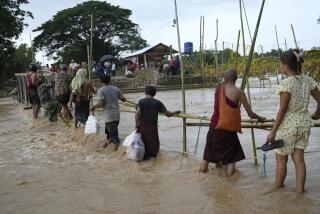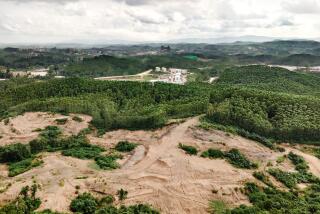Thousands still missing two days after Indonesian quake
- Share via
PADANG, INDONESIA, AND NEW DELHI — Power was out in many parts of town and some hospitals had collapsed. Cellphone networks were brittle or broken. And across the earthquake-flattened Indonesian port city of Padang on Friday, rescue teams continued to tear at the rubble and pull out bodies.
With so much of the city of 900,000 in ruins, the toll from the magnitude 7.6 temblor that struck the large island of Sumatra on Wednesday had reached 715 dead, according to an official count, and was expected to rise dramatically.
“We’ve heard it so many times: ‘Ambulance. Body bag. Ambulance. Body bag. We need more oxygen, more masks,’ ” said Aim Zein, whose indie FM radio station, PRONEWS 90, is one of the few remaining sources of information for many of Padang’s residents and is helping coordinate the relief operation.
“It’s always the same story, and the same items,” said Zein, who runs the station from his home.
Rescue efforts two days after the quake were hampered by a lack of the heavy digging equipment needed to pry apart huge slabs of concrete that fell atop one another as buildings collapsed. About 3,000 people may still be trapped beneath the rubble, and several times that number have been hospitalized, officials said.
Poor communications have limited reports from Padang’s outlying areas, where damage is also extensive and death tolls are expected to rise. A quake-triggered landslide blocked the road to the port city of Bungus to the south, severely cutting fuel supplies to the region and prompting residents to swarm gas stations for the trickle that remained available.
But Padang, the capital of West Sumatra province, may have been the hardest hit. Dozens of buildings around the city, including several government facilities, lay in ungainly heaps of concrete and twisted iron bars.
Only despair was in the air at Gedung Pelayanan Hospital on Friday night. The hospital was damaged in the quake, leaving patients hooked to IVs to be cared for under tents in the parking lot. The odor from bodies kept in a makeshift morgue up the road caused many in the crowd to cover their noses.
“You can see the condition of the hospital. We have to put the patients outside once they stabilize,” said Meta Silvia, a 22-year-old medical student who was tending to the wounded. She said surgery on the most seriously injured was being done inside; the outdoor tents were used for postoperative care.
“When they stabilize we have to put them outside,” she said. “It’s the best we can do right now.”
There were some near-miracles. Student Ratna Kurniasari Virgo, 19, was pulled alive from the rubble of her college, the Foreign Language School of Prayoga about 40 hours after the quake hit. But the chances of finding other people alive diminished with each passing hour.
The destruction of the Prayoga language school left little doubt about the fate of those inside when the quake struck. The walls of the building gave way entirely, the roof of heavy tiles now resting only a few feet off the ground on a pile of bricks. Surviving students, parents and friends walked amid the wreckage, occasionally probing at the rubble as they held a vigil for the victims.
A similar scene took place across town at the crumbled Ambacang Hotel, a colonial-style watering hole with a trendy late-night disco. Observers said hundreds of people were missing, and some in the crowd that gathered to watch the work of canine rescue teams and bulldozers insisted that as many as eight people were still alive, trapped in the hotel pool.
Rescuers pulled only four people from the site Friday. All were dead.
Despite diminished hopes, foreign governments and international aid organizations airlifted tents, water, medicine, food and emergency workers to the busy Padang airport.
Officials told the Associated Press that, based on reports from relatives, thousands of people were missing, though exact figures were unavailable. It is not unusual after natural disasters to have many people listed as missing show up alive later.
About 40 miles north of Padang, in the hilly, rural and relatively remote district of Pariaman, which has a population of just under 400,000 people, virtually no buildings remained standing, and there was little sign of outside help and little progress made in clearing landslides and blocked roads, according to an AP reporter who visited the area Friday.
The quake was centered on the same fault as the one that caused the 2004 tsunami, which killed more than 220,000 people in a dozen nations around the Indian Ocean.
Major natural disasters sometimes have political implications.
The aftermath of the 2004 tsunami saw a breakthrough in a protracted standoff between insurgents and the Indonesian government over control of the northern Sumatran province of Aceh.
A massive earthquake in the disputed Himalayan region of Kashmir in 2005 raised the profile of the Pakistani militant group Lashkar-e-Taiba when it was able to marshal aid far more quickly and efficiently than the government, earning significant goodwill among Pakistanis.
Ryan Clark, associate research fellow with the International Center for Political Violence and Terrorism Research in Singapore, said he saw little chance that Indonesia’s preeminent militant Islamic group, Jemaah Islamiah, would score points from this disaster.
“I don’t think this will be a coup for extremist groups,” he said. “By and large, the Indonesian government was on the scene immediately. And Lashkar-e-Taiba had a huge budget and was under a humanitarian umbrella, while Jemaah Islamiah doesn’t have access to that sort of infrastructure.”
But for now, the focus is on the dead and missing.
At the LIA English-language school for post-high school students, hundreds of onlookers pressed against the gates to watch the search for about 50 students left inside.
Nursim Salam, 51, was giving an exam when the earthquake struck. A teacher for 15 years, he said there were five students in the room being tested, and four waiting outside.
“When I felt the quake, I told them all to get out. I just tried to save myself. We were all panicking,” he said as the wreckage of the school was being searched behind him.
Salam was trapped under debris in the lobby for 12 hours. He didn’t know how many students had been left inside.
“I am very sorry to all the students and families,” he said.
And radio owner Zein, who spent the first two nights of the crisis pulling bodies out of the rubble, said he had become numbed by it all.
“I feel so helpless when I can’t help people live,” he said. “But you get used to it after a while -- seeing people die.”
--
McDermid is a special correspondent.
More to Read
Sign up for Essential California
The most important California stories and recommendations in your inbox every morning.
You may occasionally receive promotional content from the Los Angeles Times.










